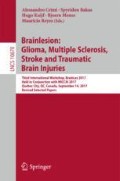Abstract
Brain tumor segmentation plays an important role in the disease diagnosis. In this paper, we proposed deep learning frameworks, i.e. MvNet and SPNet, to address the challenges of multimodal brain tumor segmentation. The proposed multi-view deep learning framework (MvNet) uses three multi-branch fully-convolutional residual networks (Mb-FCRN) to segment multimodal brain images from different view-point, i.e. slices along x, y, z axis. The three sub-networks produce independent segmentation results and vote for the final outcome. The SPNet is a CNN-based framework developed to predict the survival time of patients. The proposed deep learning frameworks was evaluated on BraTS 17 validation set and achieved competing results for tumor segmentation While Dice scores of 0.88, 0.75 0.71 were achieved for whole tumor, enhancing tumor and tumor core, respectively, an accuracy of 0.55 was obtained for survival prediction.
Access this chapter
Tax calculation will be finalised at checkout
Purchases are for personal use only
References
Menze, B.H., Jakab, A., Bauer, S., Kalpathycramer, J., Farahani, K., Kirby, J., Burren, Y., Porz, N., Slotboom, J., Wiest, R.: The multimodal brain tumor image segmentation benchmark (BRATS). IEEE Trans. Med. Imaging 34, 1993–2024 (2015)
Previous BraTS Challenges. http://www.braintumorsegmentation.org/
Bakas, S., Akbari, H., Sotiras, A., Bilello, M., Rozycki, M., Kirby, J., Freymann, J., Farahani, K., Davatzikos, C.: Advancing the Cancer Genome Atlas glioma MRI collections with expert segmentation labels and radiomic features. Nature Scientific Data (2017, in press)
Shelhamer, E., Long, J., Darrell, T.: Fully convolutional networks for semantic segmentation. In: IEEE Conference on Computer Vision and Pattern Recognition, pp. 3431–3440 (2015)
Badrinarayanan, V., Kendall, A., Cipolla, R.: SegNet: a deep convolutional encoder-decoder architecture for scene segmentation. IEEE Trans. Pattern Anal. Mach. Intell. 39(12), 2481–2495 (2017)
Kamnitsas, K., Ledig, C., Newcombe, V.F., Simpson, J.P., Kane, A.D., Menon, D.K., Rueckert, D., Glocker, B.: Efficient multi-scale 3D CNN with fully connected CRF for accurate brain lesion segmentation. Med. Image Anal. 36, 61 (2016)
Havaei, M., Davy, A., Warde-Farley, D., Biard, A., Courville, A., Bengio, Y., Pal, C., Jodoin, P.M., Larochelle, H.: Brain tumor segmentation with Deep Neural Networks. Med. Image Anal. 35, 18–31 (2017)
Fidon, L., Li, W., Garcia-Peraza-Herrera, L.C., Ekanayake, J., Kitchen, N., Ourselin, S., Vercauteren, T.: Scalable multimodal convolutional networks for brain tumour segmentation. In: International Conference on Medical Image Computing and Computer-Assisted Intervention, pp. 285–293 (2017)
Tseng, K.L., Lin, Y.L., Hsu, W., Huang, C.Y.: Joint sequence learning and cross-modality convolution for 3D biomedical segmentation. arXiv e-print arXiv:1704.07754 (2017)
Zhou, M., Chaudhury, B., Hall, L.O., Goldgof, D.B., Gillies, R.J., Gatenby, R.A.: Identifying spatial imaging biomarkers of glioblastoma multiforme for survival group prediction. J. Magn. Reson. Imaging 46(1), 115–123 (2016)
Lao, J., Chen, Y., Li, Z.C., Li, Q., Zhang, J., Liu, J., Zhai, G.: A deep learning-based radiomics model for prediction of survival in glioblastoma multiforme. Sci. Rep. 7, 10353 (2017)
Nyul, L.G., Udupa, J.K., Zhang, X.: New variants of a method of MRI scale standardization. IEEE Trans. Med. Imaging 19, 143–150 (2000)
Ioffe, S., Szegedy, C.: Batch normalization: accelerating deep network training by reducing internal covariate shift. In: International Conference on Machine Learning, pp. 448–456 (2015)
He, K., Zhang, X., Ren, S., Sun, J.: Deep residual learning for image recognition. In: IEEE Conference on Computer Vision and Pattern Recognition, pp. 770–778 (2016)
Deng, J., Dong, W., Socher, R., Li, L.J., Li, K., Li, F.F.: ImageNet: a large-scale hierarchical image database. In: IEEE Conference on Computer Vision and Pattern Recognition, pp. 248–255 (2009)
Ronneberger, O., Fischer, P., Brox, T.: U-Net: convolutional networks for biomedical image segmentation. In: Navab, N., Hornegger, J., Wells, W.M., Frangi, A.F. (eds.) MICCAI 2015. LNCS, vol. 9351, pp. 234–241. Springer, Cham (2015). https://doi.org/10.1007/978-3-319-24574-4_28
Lin, M., Chen, Q., Yan, S.: Network in Network. arXiv e-print arXiv:1312.4400 (2013)
Lin, T.Y., Goyal, P., Girshick, R., He, K., Dollár, P.: Focal loss for dense object detection. In: IEEE International Conference on Computer Vision (2017)
Kingma, D.P., Ba, J.: Adam: a method for stochastic optimization. arXiv e-print arXiv:1412.6980 (2014)
Bakas, S., Akbari, H., Sotiras, A., Bilello, M., Rozycki, M., Kirby, J., Freymann, J., Farahani, K., Davatzikos, C.: Segmentation labels and radiomic features for the pre-operative scans of the TCGA-GBM collection. The Cancer Imaging Archive (2017). https://doi.org/10.7937/k9/tcia.2017.klxwjj1q
Bakas, S., Akbari, H., Sotiras, A., Bilello, M., Rozycki, M., Kirby, J., Freymann, J., Farahani, K., Davatzikos, C.: Segmentation labels and radiomic features for the pre-operative scans of the TCGA-LGG collection. The Cancer Imaging Archive (2017). https://doi.org/10.7937/k9/tcia.2017.gjq7r0ef
Acknowledgement
The work was supported by Natural Science Foundation of China under grands no. 61672357 and 61702339, the Science Foundation of Shenzhen under Grant No. JCYJ20160422144110140, and the China Postdoctoral Science Foundation under Grant No. 2017M622779.
Author information
Authors and Affiliations
Corresponding author
Editor information
Editors and Affiliations
Rights and permissions
Copyright information
© 2018 Springer International Publishing AG, part of Springer Nature
About this paper
Cite this paper
Li, Y., Shen, L. (2018). Deep Learning Based Multimodal Brain Tumor Diagnosis. In: Crimi, A., Bakas, S., Kuijf, H., Menze, B., Reyes, M. (eds) Brainlesion: Glioma, Multiple Sclerosis, Stroke and Traumatic Brain Injuries. BrainLes 2017. Lecture Notes in Computer Science(), vol 10670. Springer, Cham. https://doi.org/10.1007/978-3-319-75238-9_13
Download citation
DOI: https://doi.org/10.1007/978-3-319-75238-9_13
Published:
Publisher Name: Springer, Cham
Print ISBN: 978-3-319-75237-2
Online ISBN: 978-3-319-75238-9
eBook Packages: Computer ScienceComputer Science (R0)

